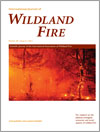International Journal of Wildland Fire
Volume 20
Number 6 2011
Prescribed burning, or the deliberate application of fire, is a commonly used management tool worldwide. Studies show that prescribed burning may improve control of wildfires, but has less value in affecting the extent of area affected by wildfires. There is insufficient information relating to the costs and benefits of prescribed fire for biodiversity. We identify issues that need to be addressed to improve management of prescribed burning programs.
The obstruction of ambient winds and the possible existence of indrafts downwind of a wildfire is one aspect of coupled fire–atmosphere interaction influencing the effectiveness of backfiring. Three-dimensional simulations of heading fires and backfires in surface fuels suggest that these influences are quite sensitive to environmental conditions.
Post-fire tree mortality was concentrated in the first 2 years following fire but continued to occur over 10 years. The time snags stood after fire and factors influencing their persistence were species-specific. These multiscaled factors included diameter, fire severity, stand basal area and salvage logging in the vicinity. Tree fall pattern also differed among species.
We evaluated characteristics of fuel breaks that influenced the behaviour of large fires and mapped where fires and fuel breaks most commonly intersect. Fuel breaks were most effective when they provided access for firefighting activities, and most fires intersect fuel breaks in historically fire-prone areas.
This study developed methods to integrate artificial neural network models with geographic information system tools and produced a prototype forest-fire susceptibility map for the Central Portugal administrative area.
We investigated the influences of forest roads on wildfire cessation. The locations of wildfire boundaries were influenced by multiple topographic and vegetation constraints, but forest roads tend to have largest influence. We interpreted these results as evidence that roads provide accessibility for more effective firefighting and act as physical barriers to fire spread
A method was developed to determine degree of grassland curing in the field. It is a less subjective method than visual observations, and is easily carried out by operational personnel. This method also provides important field data to assist in the development of new techniques for grass curing assessment and accurate determination of fire danger potential in grasslands.




